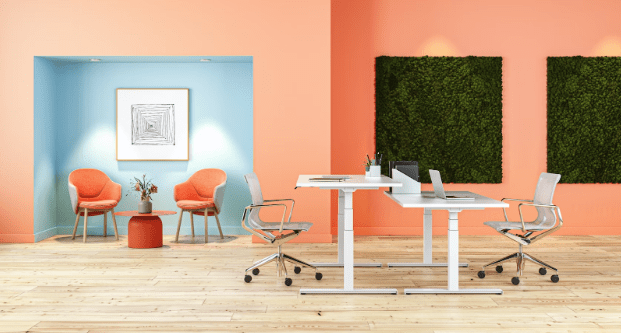A modern workforce expects more from an office than Wi-Fi and a water cooler. In fast-paced sectors like logistics, tech, and ecommerce, the design of a workspace can push a team forward or quietly hold it back.
Read also: Designing Digital Security Infrastructure for a Decentralized Workforce
The days of inflexible designs and countless rows of identical seats are long gone. Today’s offices need to be as agile and thoughtful as the people working in them.
Space That Fits the Task
Work doesn’t happen in a straight line. Neither should the layout.
A developer might start the morning debugging code in a quiet pod, meet with the product team by noon, and wrap up with admin work in a shared space by three. One room won’t cover that range.
Modern designs use clearly defined zones:
- Focus areas with acoustic privacy and minimal distractions
- Open collaboration spaces with writable walls, movable seating, and plenty of light
- Social corners for relaxing, spontaneous chats, or even solo resets
These zones aren’t luxuries. They’re practical responses to how people actually move through their day.
Tech That Doesn’t Get in the Way
Nobody enjoys starting a meeting by crawling under the table for a cable. When technology is properly integrated into the space, it stops being a speed bump and becomes invisible support.
Smart office tech includes:
- Easily accessible power and USB ports
- Conference screens that connect instantly
- Lighting and temperature controls that adapt to time of day or occupancy
- Noise masking systems to reduce distractions
When the tools work smoothly, people can focus. In industries driven by speed and accuracy, that focus makes a difference.
Logistics Teams Deserve Better Office Design
Design conversations often focus on creatives or engineers, while logistics professionals are left with leftover space. That’s a miss.
Logistics staff handle real-time changes, tight schedules, and constant communication. Their workspace should reflect the pace and precision their job requires.
They benefit from:
- Command zones with multiple monitors and real-time dashboards
- Quiet booths for time-sensitive calls
- Shared spaces near screens or status boards for rapid decision-making
In hybrid operations, where part of the team works from warehouses or on the move, the office still needs to anchor the team. Layouts that allow seamless connection between on-site and off-site roles reduce friction and keep communication flowing, as seen in emerging split-office strategies adopted by forward-thinking logistics companies.
Furniture That Moves with the Team
Office furniture is about comfort and effective workflow. Which is why the best setups often include:
- Desks with adjustable heights for sitting or standing
- Modular tables that can be pushed together or apart depending on the project
- Mobile storage units that shift with people, not against them
- Cable management systems that reduce clutter
In rapidly changing work settings, the furniture must adapt quickly.. Smart, minimal designs like the ones in many modern office desk collections offer flexibility without sacrificing structure. The goal is to support movement, not get in the way of it.
Don’t Guess—Observe
Some of the most successful office changes have come from observation, not assumption.
One ecommerce team realized their sleek new boardroom barely got used. Why? Employees found the lighting was harsh, and the furniture a little too stiff. Meanwhile, a smaller room near the windows kept filling up, even for casual chats.
Before you renovate, gather data:
- Which rooms get used the most?
- Are desks staying empty while couches stay occupied?
- Do people choose quiet corners over high-traffic zones?
Ask the team. Watch the patterns. Then design accordingly.
Subtle Sustainability
The next-gen workforce notices the everyday details—like whether their chair is made from recycled materials or if there’s natural light over artificial glare.
Simple improvements can go far:
- LED lights with motion sensors
- Air purifiers and good ventilation
- Recycled fabrics and low-impact flooring
These changes create a healthier environment and demonstrate values that resonate with employees, especially those choosing between multiple employers.
The Office Isn’t Gone, Just Different
Remote work reshaped the conversation around space. But it didn’t erase the need for physical offices.
What’s changing is why people come in. They show up to collaborate, to connect, and to recharge with their peers. Not because someone’s watching the clock.
The modern office supports that shift with:
- Fewer fixed desks and more hot desks
- Comfortable lounge seating in natural light
- Private areas for video calls or personal focus
- Community kitchens that actually invite conversation
These aren’t perks. They’re the new basics of a space designed around real human behavior.
The Takeaway
Office design isn’t about aesthetics alone. It’s about removing friction, improving comfort, and helping people think clearly in high-pressure environments.
For logistics teams balancing urgency, tech teams building fast, and ecommerce teams scaling daily, the workspace plays a quiet but critical role. When design supports the way people think and move, everything from creativity to output improves.
If your space still runs on 2010 logic, now’s the time to catch up. Don’t guess. Observe. Ask. Adjust.
Work has changed. The best offices already have.
Author Bio
Edrian is a college instructor turned wordsmith, with a passion for both teaching and writing. With years of experience in higher education, he brings a unique perspective to his writing, crafting engaging and informative content on a variety of topics. Now, he’s excited to explore his creative side and pursue content writing as a hobby.

